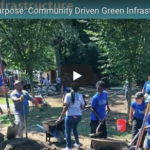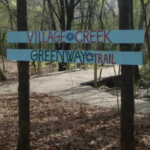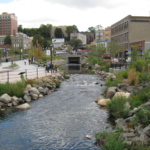Green spaces and areas of recreation have been well documented to provide mental and physical health benefits to the people living around them. Restored environments also help to sustain animal and plant life, supporting a whole ecosystem approach to combating water contamination, flooding, and air pollution. Given the benefits of green spaces near urban waterways, members of the UWLN are working to create more green spaces in communities most affected by environmental injustices in a variety of different ways: building greenways, installing green infrastructure, and converting vacant lots to parks. Find learning sessions, stories and more resources below.
Webinars
 Parks with Purpose: Community Driven Green Infrastructure
Parks with Purpose: Community Driven Green Infrastructure
Green infrastructure projects have the potential to benefit both the environment and the community. Through their Parks with Purpose program, The Conservation Fund and partner organizations are designing and implementing green infrastructure in underserved urban communities while engaging and training residents to make way for lasting change.
 Greenways: The Urban Waters Experience
Greenways: The Urban Waters Experience
Recorded webinar presenting 3 successful efforts to convert brownfields and vacant city lots into parks, green spaces and greenways. Examples hail from Birmingham, AL; Cincinnati, OH; and Kansas City, MO. Presenters include: Ryan Parker (Freshwater Land Trust); Robin Corathers (Groundwork Cincinnati) & Jill Erickson (Heartland Conservation Alliance)

Story Maps
Green Spaces for Urban Communities
Read about how three Urban Waters Learning Network organizations–Groundwork Hudson Valley, The Conservation Fund, and Groundwork Richmond–are working to create more green spaces in communities most affected by environmental injustices. The highlighted projects (blue stars) have integrated significant community engagement components in the development of green spaces. Community involvement can help to create a sense of community ownership over the new parks and greenways, providing a sense of place-making and community presence.
Green Infrastructure: Multiple Benefits for Urban Waters Communities
The modern built urban landscape impedes the natural processes and changes the environments. Often, they are eliminated altogether. As a result, urban hydrology is complex and changing. Water flow paths, pollutant discharges, and flood impacts are more difficult to project on an ongoing basis. Urban areas are subject to the impacts of increased flood peaks, stormwater run-off, water quality issues, and increased heat. Climate change and historical inequities compound all these. There is seldom a single solution for these multiple issues that urban communities face. Green infrastructure comes pretty close, especially when planned, designed, and implemented equitably. Members of the Urban Waters Learning Network (UWLN) are working on green infrastructure to address different environmental issues. Case study examples highlighted here come from Providence, RI; New Orleans, LA, and Tucson, AZ.
Additional Resources
Impact Stories
- Groundwork Richmond: Greening the Urban Landscape
- Groundwork Elizabeth: Reconnecting the City and the River
- Reclaiming Urban Waterways—Daylighting the Saw Mill River
- Vacant Lots to Greenways in Kansas City
Reports
- Urban River Parkways–An Essential Tool for Public Health
- Greening the Jade: an Economic Analysis of the Costs and Benefits of Urban Greening in SE Portland
- Connecting Passaic to the River: Dundee Island Waterfront Park and Community Engagement Profile
- Urban Nature for Human Health and Well Being
- Sharing in the Benefits of a Greening City

